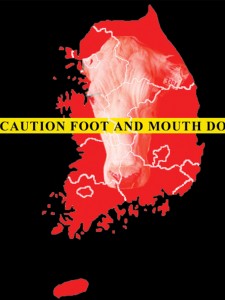 South Korea was unable to shake off foot-and-mouth disease (FMD) in 2010. As the third outbreak of the year continues into 2011, the cull in South Korea has now surpassed the total of the 2002 outbreak (160,000) by 4-fold, reaching over 660,000 animals. One report stated, “The animal disease has effectively spread across the country despite extensive quarantine efforts.” My conclusion, the disease had spread widely before quarantine efforts began.
South Korea was unable to shake off foot-and-mouth disease (FMD) in 2010. As the third outbreak of the year continues into 2011, the cull in South Korea has now surpassed the total of the 2002 outbreak (160,000) by 4-fold, reaching over 660,000 animals. One report stated, “The animal disease has effectively spread across the country despite extensive quarantine efforts.” My conclusion, the disease had spread widely before quarantine efforts began.
Eighty-four livestock markets in a country half the size of New England were closed as of late December to stop the spread of disease in this round which began at the end of November. By early January 2011, vaccination of susceptible livestock began.
Quick quiz:
Q1: Will quarantine of infected premises stop the spread of FMD?
Q2: Will other infected premises be found after quarantine and stop movement orders are put into effect?
Meanwhile, in the western hemisphere, efforts to eradicate FMD continue. The chief of the World Organization for Animal Health (OIE), Bernard Vallat, believes “the Americas, with political will and necessary resources, can realize eradication of the disease.” When you think about the countries of Central and South America where FMD is still endemic–Ecuador, Bolivia, and Venezuela–the truth of Vallat’s words become obvious, particularly the reference to political will.
Quiz answers:
A1: From the quarantined premises, yes. From undiscovered premises, no. Disease will already have had time to spread by the time a farm is quarantined. Regional stop movements and enforcement of effective cleaning and disinfection are likely to be more effective in stopping the spread of disease.
A2: Yes. It is very important to realize the moment disease is found on one farm, it has very likely spread to others. The trace back/trace forward investigation conducted on identified farms is critical to quickly bringing the disease under control. The linkages from infected farms can determine the size of control zones and influence the consideration of other control measures.
Recognition of this last point and willingness to cooperate by voluntarily implementing strict biosecurity by owners of susceptible livestock farms is needed to contain such a highly contagious disease.

